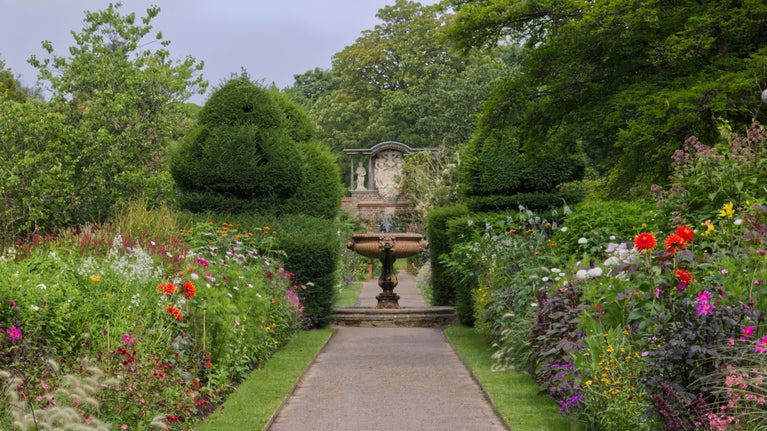
Gardens and landscapes
Find out more about the historical landscapes that the talented garden teams work hard to conserve at the places you love to visit.

The UK is the world’s biggest grower of daffodils and they're woven into stories at many of the places in our care. Learn about the daffodil's origins, how there came to be so many varieties and how they've inspired poets and authors throughout the centuries.
The botanical name for the daffodil is Narcissus, named after a young man known for his beauty in Greek mythology who was tricked into falling in love with his own reflection. The drooping flowers that characterise most daffodils are said to represent Narcissus bending over to catch his reflection in a pool of water.
The name derives from the Greek ‘narco’, which is the root of the word narcotic. The etymology probably relates to the daffodil's toxicity – all parts of the plant are poisonous.
The Romans are known to have planted daffodils in memory of loved ones or comrades fallen in battle. It’s likely they brought them to Britain from the Iberian Peninsula, predominantly Spain and Portugal, where the largest variety of daffodil species are found.
Daffodils’ uplifting yellow flowers and true perennial habit make them an enduring garden favourite. Clumps of daffodil bulbs have been known to survive in the ground for well over a century, flowering consistently for decades.
There are more than 27,000 cultivated varieties. Despite intensive breeding, most daffodils are yellow. Exceptions include the white-petalled Narcissus poeticus varieties and orange and salmon-coloured cultivars.

It can take five years for a daffodil to flower from a seed. Until the 19th century, daffodils were either wild species or natural hybrids that had slowly increased in number over time. The modern daffodil evolved during the 1800s when plant cultivators began to select flowers for different aesthetic qualities.
The Rev. George Herbert Engleheart is often credited as the father of the modern daffodil. He registered 720 new daffodil varieties between 1882 and 1923, although only around 30 are still commercially available. The N. poeticus species is the most well known.
A method of classifying daffodils based on their different forms and origins was developed by the RHS Daffodil Committee in 1950. There are 13 different divisions and these are still used today. These are some of the most common.
Daffodils have inspired writers, poets and artists through the centuries. A favourite flower among the Romantic poets, they were immortalised by Wordsworth in his poem Daffodils, one of the most famous poems in the English language.
The poet’s line ‘A host of golden daffodils’ recalls the swathes of wild flowers discovered on a walk with his sister Dorothy along the shore of Ullswater in the Lake District in early April 1802.
Over the centuries, daffodils have been given many common or local names, including the 'daffodowndilly', 'yellow maiden' and 'Lent lily', which is a reference to their flowering season coinciding with the period leading up to Easter.
'Daffodowndilly' was writer AA Milne’s choice for his poem about the flower, published in his book of verse for children, When We Were Very Young (1924).
She wore her yellow sun-bonnet, She wore her greenest gown; She turned to the south wind, And curtsied up and down.
From rare heritage varieties along the Tamar valley at Cotehele in Cornwall and Saltram in Devon to the daffodil memorial at Dora's Field in the Lake District, daffodils have played an important role in the history of many of the places in our care.
Cotehele in Cornwall has a particularly unique collection of daffodils. Varieties include 19th-century hybrids, the surviving remnants of a major flower industry which once thrived along the Tamar valley.
Generations of families worked in fields known locally as ‘Little Gardens’, supplying flowers and fresh produce to national markets which flourished with the development of railways.
The industry declined after the Second World War and many of the old fields became overgrown and lost. Daffodil bulbs were discarded into hedgerows and the surrounding countryside where they continued to bloom, largely forgotten, for decades.
The gardeners and volunteers at Cotehele rescued many of these rare daffodils with the help from a local grower who donated old bulbs. Catalogued and protected, they now grow alongside other historic daffodil varieties which have been established in the garden.

Find out more about the historical landscapes that the talented garden teams work hard to conserve at the places you love to visit.
Tulips have been a popular flower for centuries. Find out where they came from, how they inspired the 'tulipmania' craze and learn about the different varieties you can still spot today.

Uncover the horticultural history of the dahlia, from its origins in Central America to becoming an inspiration for legendary crime writer Agatha Christie.

Enjoy a dazzling display of daffodils at Cotehele estate in spring, when the estate is filled with different varieties, some dating back to the 17th century.
